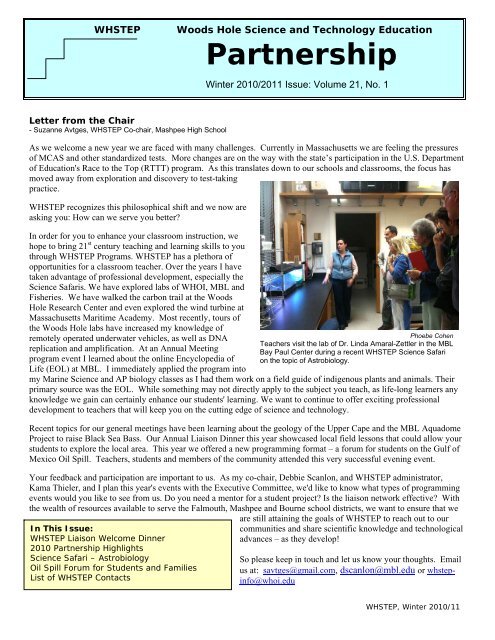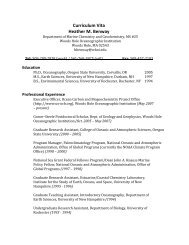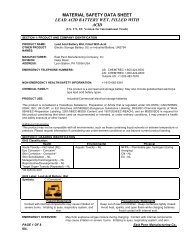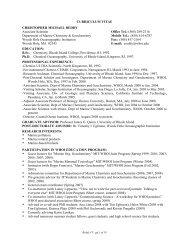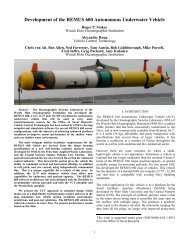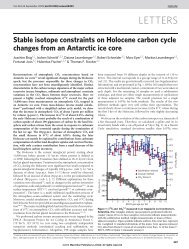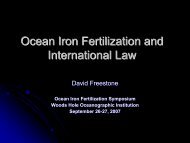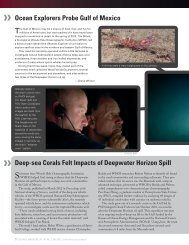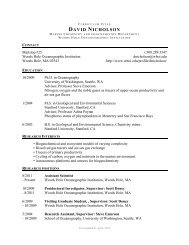Partnership - Woods Hole Oceanographic Institution
Partnership - Woods Hole Oceanographic Institution
Partnership - Woods Hole Oceanographic Institution
You also want an ePaper? Increase the reach of your titles
YUMPU automatically turns print PDFs into web optimized ePapers that Google loves.
WHSTEP <strong>Woods</strong> <strong>Hole</strong> Science and Technology Education<br />
Letter from the Chair<br />
- Suzanne Avtges, WHSTEP Co-chair, Mashpee High School<br />
<strong>Partnership</strong><br />
Winter 2010/2011 Issue: Volume 21, No. 1<br />
As we welcome a new year we are faced with many challenges. Currently in Massachusetts we are feeling the pressures<br />
of MCAS and other standardized tests. More changes are on the way with the state’s participation in the U.S. Department<br />
of Education's Race to the Top (RTTT) program. As this translates down to our schools and classrooms, the focus has<br />
moved away from exploration and discovery to test-taking<br />
practice.<br />
WHSTEP recognizes this philosophical shift and we now are<br />
asking you: How can we serve you better?<br />
In order for you to enhance your classroom instruction, we<br />
hope to bring 21 st century teaching and learning skills to you<br />
through WHSTEP Programs. WHSTEP has a plethora of<br />
opportunities for a classroom teacher. Over the years I have<br />
taken advantage of professional development, especially the<br />
Science Safaris. We have explored labs of WHOI, MBL and<br />
Fisheries. We have walked the carbon trail at the <strong>Woods</strong><br />
<strong>Hole</strong> Research Center and even explored the wind turbine at<br />
Massachusetts Maritime Academy. Most recently, tours of<br />
the <strong>Woods</strong> <strong>Hole</strong> labs have increased my knowledge of<br />
remotely operated underwater vehicles, as well as DNA<br />
replication and amplification. At an Annual Meeting<br />
program event I learned about the online Encyclopedia of<br />
Life (EOL) at MBL. I immediately applied the program into<br />
my Marine Science and AP biology classes as I had them work on a field guide of indigenous plants and animals. Their<br />
primary source was the EOL. While something may not directly apply to the subject you teach, as life-long learners any<br />
knowledge we gain can certainly enhance our students' learning. We want to continue to offer exciting professional<br />
development to teachers that will keep you on the cutting edge of science and technology.<br />
Recent topics for our general meetings have been learning about the geology of the Upper Cape and the MBL Aquadome<br />
Project to raise Black Sea Bass. Our Annual Liaison Dinner this year showcased local field lessons that could allow your<br />
students to explore the local area. This year we offered a new programming format – a forum for students on the Gulf of<br />
Mexico Oil Spill. Teachers, students and members of the community attended this very successful evening event.<br />
Your feedback and participation are important to us. As my co-chair, Debbie Scanlon, and WHSTEP administrator,<br />
Kama Thieler, and I plan this year's events with the Executive Committee, we'd like to know what types of programming<br />
events would you like to see from us. Do you need a mentor for a student project? Is the liaison network effective? With<br />
the wealth of resources available to serve the Falmouth, Mashpee and Bourne school districts, we want to ensure that we<br />
In This Issue:<br />
WHSTEP Liaison Welcome Dinner<br />
2010 <strong>Partnership</strong> Highlights<br />
Science Safari – Astrobiology<br />
Oil Spill Forum for Students and Families<br />
List of WHSTEP Contacts<br />
Phoebe Cohen<br />
Teachers visit the lab of Dr. Linda Amaral-Zettler in the MBL<br />
Bay Paul Center during a recent WHSTEP Science Safari<br />
on the topic of Astrobiology.<br />
are still attaining the goals of WHSTEP to reach out to our<br />
communities and share scientific knowledge and technological<br />
advances – as they develop!<br />
So please keep in touch and let us know your thoughts. Email<br />
us at: savtges@gmail.com, dscanlon@mbl.edu or whstepinfo@whoi.edu<br />
WHSTEP, Winter 2010/11
WHSTEP 2010 Highlights<br />
In January, the WHSTEP General Meeting was held at the <strong>Woods</strong> <strong>Hole</strong> Research Center (WHRC). About 30 teachers,<br />
students, institution liaisons, and members of the public heard an interesting summary of the meetings at the 15 th Conference of<br />
the Parties (COP 15) of the United Nations Framework Convention on Climate Change in Copenhagen. Attendees also learned<br />
about WHRC’s green building, completed in 2003, and its on-site education trail.<br />
For 13 years, WHSTEP has organized a science project mentoring program at the Lawrence School in Falmouth. Members<br />
of the WHSTEP scientific community volunteer their time to meet with 7 th and 8 th grade students and help them design and<br />
refine their science projects. This year, mentoring took place over a week in early February. Thirty volunteers participated from<br />
MBL, WHOI, USGS, WHRC, SEA, and WBNERR.<br />
WHSTEP arranged for science institution exhibits at the Falmouth District Science Fair in late February. Students and families<br />
enjoyed the informative and interactive displays. The inaugural Bourne Science Fair, sponsored by the PTA, was held in mid-<br />
March at Bourne Middle School. WHOI, USGS, MBL Marine Resources Center and the Encyclopedia of Life project exhibited<br />
at the Fair.<br />
In April, a WHSTEP Science Safari “Exploring Local Conservation Lands” was held in East Falmouth, originating at the East<br />
Falmouth School and culminating with a walk through a nearby conservation property on Green Pond. Local author, naturalist<br />
and educator Beth Schwarzman led the safari. Teachers received ideas for activities, as well as maps and information<br />
highlighting conservation parcels near each school in Falmouth, Mashpee and Bourne.<br />
In May, nearly 100 friends and supporters of WHSTEP turned out to celebrate its 20 th Anniversary at WHOI’s Clark Building.<br />
Several of the WHSTEP founders and early advocates attended along with active and retired teachers and scientific institution<br />
staff. Keynote speaker was WHOI’s Director of Special Projects, Dr. David Gallo. Each school district and scientific institution<br />
sent its superintendent, director, or representative to congratulate and encourage WHSTEP.<br />
In early October, WHSTEP hosted a forum on the Gulf of Mexico oil spill for students and their parents and teachers at<br />
Falmouth High School. A panel of 5 speakers from WHOI, USGS, and the National Park Service spoke about oil formation in<br />
the Gulf, their experiences surveying the spill from research ships, technology used to detect oil in the ocean, and spill’s effect<br />
on wildlife, marshes and beaches. The students, grades 4-12, then had the opportunity to ask questions of the panelists.<br />
In mid-October, the annual WHSTEP Liaison Welcome Dinner was held at the Landfall Restaurant in <strong>Woods</strong> <strong>Hole</strong> with 35<br />
attendees. Outreach and education staff from the science institutions and local informal science programs presented<br />
opportunities for student field trips and field experiences. School and institution liaisons, elementary, middle and high school<br />
teachers, school administrators and scientists enjoyed an evening of networking and planning.<br />
In mid-November a WHSTEP Science Safari “What is Life and How Do We Detect It?” was presented at the Marine<br />
Biological Laboratory by the NASA Astrobiology outreach team. Teachers learned about what Astrobiology is and how to use<br />
it in teaching students basic science concepts, and tried out three hands-on activities for easy transference into the classroom.<br />
Then they visited the lab of Dr. Linda Amaral-Zettler to learn about her research on acid-tolerant microbes from the Rio Tinto<br />
in Spain. Teachers received many materials including the Astrobiology Teachers Guide.<br />
On-going projects:<br />
� Through the Registry of Science Outreach Volunteers (WHSTEP R.O.V.) and our liaison network, WHSTEP links<br />
teachers with researchers and materials from the member scientific institutions, and links researchers with schools to<br />
fulfill their outreach goals. Some examples from 2010 include finding scientists to visit classrooms and collaborate on<br />
lesson plans, arranging field trips to <strong>Woods</strong> <strong>Hole</strong> institutions, collaborating on the GLOBE student water sampling<br />
program with WHOI, and partnering on a NOAA Environmental Literacy Grant proposal.<br />
� WHSTEP awards mini-grants to support and enhance science, math and technology education in our member schools.<br />
This year’s funded projects were the LEGO Club at Bournedale Elementary School to provide gears, wheels and other<br />
LEGO components for the new enrichment club; funds for supplies for the Cross-Age Science Teaching program in<br />
which Lawrence School 8 th graders teach concepts of electricity to 3 rd grade students in Falmouth; and a project at<br />
Peebles Elementary School in Bourne to provide supplies and equipment for a hands-on science program, based on<br />
standards in the elementary science curriculum, and to promote participation in the yearly science fair.<br />
� “<strong>Partnership</strong>”, the WHSTEP newsletter, is published bi-annually and distributed to a mailing list of over 400 people.<br />
� WHSTEP administers an email listserv to publicize our programming and meetings, as well as relevant local<br />
workshops and lectures on topics of science, math and technology.<br />
WHSTEP, Winter 2010/11
WHSTEP Liaison Welcome Dinner<br />
- Debbie Scanlon<br />
The annual WHSTEP liaison dinner was held on<br />
October 20, 2010 at the Landfall Restaurant in <strong>Woods</strong><br />
<strong>Hole</strong>. This year's program featured presentations to<br />
teachers on field trips and field experiences for their<br />
students. Eight scientists and outreach staff members<br />
brought displays about lab and ship tours, aquarium<br />
visits and exhibits, and hands-on collecting trips that<br />
are available nearby.<br />
Anne Thessen of the Encyclopedia of Life (EOL) and<br />
the Marine Biological Laboratory (MBL), presented<br />
information on EOL's efforts to gather information on<br />
all the Earth's animals, plants and microorganisms and<br />
make it available as a web-based resource. Pam<br />
Wilmot of MBL shared information on tours of the<br />
MBL and its Marine Resources Center. Kathy<br />
Zagzebski of the National Marine Life Center in<br />
Buzzards Bay brought a display on her center's rescues<br />
of stranded marine animals. Abbey Spargo from Ocean<br />
Explorium at the New Bedford Seaport explained her<br />
organization's ocean science public education program,<br />
and Joan Muller from Waquoit Bay National Estuarine<br />
Research Reserve presented the research reserve's<br />
educational programs. Information on the <strong>Woods</strong> <strong>Hole</strong><br />
<strong>Oceanographic</strong> <strong>Institution</strong> Ocean Sciences Exhibit<br />
Center and tours was presented by Karen Damelio of<br />
WHOI Exhibit Center, and Kathleen Savage of <strong>Woods</strong><br />
<strong>Hole</strong> Research Center explained the center's educational<br />
trail and "green" building. Rob Reynolds of Zephyr<br />
Education Foundation presented information on marine<br />
collecting boat trips and field studies.<br />
Thirty-five school and institution liaisons, elementary,<br />
middle and high school teachers, school administrators<br />
and scientists attended and enjoyed networking and<br />
planning.<br />
Debbie Scanlon<br />
Kathy Zagzebski (left) describes the programs at the<br />
National Marine Life Center in Buzzards Bay to Bob<br />
Laquidara, Lawrence School.<br />
Special thanks to Don Estes, owner of the Landfall<br />
Restaurant and member of the WHSTEP Executive<br />
Committee, who donated use of the restaurant for the<br />
event, and to the scientific institutions that provided<br />
literature, maps and other educational material for the<br />
teachers and raffle prizes.<br />
Debbie Scanlon<br />
Chloe Starr (left) and Kathleen Savage of <strong>Woods</strong> <strong>Hole</strong><br />
Research Center and Gordon Starr of Teaticket School<br />
discuss student field trips to the Center's education trail.<br />
Liaison Dinner presenters and web resources:<br />
Encyclopedia of Life Outreach and Education<br />
http://education.eol.org/<br />
Marine Biological Laboratory Tours<br />
http://www.mbl.edu/about/visit/visit_tours.html<br />
National Marine Life Center, Buzzards Bay<br />
http://nmlc.org/<br />
NOAA Marine Fisheries <strong>Woods</strong> <strong>Hole</strong> Science<br />
Aquarium<br />
http://aquarium.nefsc.noaa.gov/<br />
Ocean Explorium at New Bedford Seaport<br />
http://www.oceanexplorium.org/<br />
Waquoit Bay National Estuarine Research Reserve<br />
Educational Programs<br />
www.waquoitbayreserve.org<br />
<strong>Woods</strong> <strong>Hole</strong> <strong>Oceanographic</strong> <strong>Institution</strong> Ocean<br />
Sciences Exhibit Center and Tours<br />
http://www.whoi.edu/page.do?pid=9135<br />
<strong>Woods</strong> <strong>Hole</strong> Research Center Education Trail and<br />
Green Building<br />
www.whrc.org<br />
Zephyr Education Foundation Boat Trips and Field<br />
Studies<br />
http://www.zephyrmarine.net/<br />
WHSTEP, Winter 2010/11
WHSTEP Science Safari : Bringing<br />
Astrobiology into the Classroom<br />
- Debbie Scanlon and Kama Thieler<br />
"What is life, and how do we detect it?" was the theme<br />
for the WHSTEP Fall Science Safari at Marine<br />
Biological Laboratory in November 17, 2010. Led by<br />
Peter Mangiafico and Michele Bahr of MBL and Phoebe<br />
Cohen of Massachusetts Institute of Technology, the<br />
two-hour teacher workshop was designed to bring the<br />
topic of Astrobiology into the classroom.<br />
Astrobiology is the<br />
study of the origins,<br />
evolution, and future<br />
of life in the<br />
Universe. It is<br />
interdisciplinary by<br />
nature, incorporating<br />
life science, Earth<br />
and space science,<br />
math and physics.<br />
Teachers and other<br />
interested<br />
participants took<br />
part in four activities<br />
focused on defining<br />
life and how we<br />
look for life on<br />
Earth and other<br />
planets. The<br />
Debbie Scanlon<br />
Lee Campbell, WHSTEP, and Tim<br />
Willmott, Upper Cape Tech, look<br />
for evidence of life in an activity in<br />
the Astrobiology safari.<br />
activities were chosen for easy transference to the<br />
classroom. In the first activity, participants used the<br />
“Near and Far” and “Small and Large” card games from<br />
the Alien Earths Program to gain perspective on the<br />
scale and structure of the Universe. They sorted 10<br />
images of Earthly and celestial objects (including an<br />
eagle, the space shuttle and the Hubble Deep Field view)<br />
in order of their distance from Earth's surface and<br />
according to their size.<br />
In the next activity, participants were asked to look at a<br />
series of pictures, including jellyfish, sponges, and<br />
crystals, and for each one, answer, "Is it alive?" and<br />
"Why?" As they discussed each image, they were asked<br />
to write down characteristics of life.<br />
The final two activities can be found in the NASA<br />
Astrobiology Educator Resource Guide (see sidebar).<br />
Each group received three jars that contained<br />
combinations of sand, sugar, yeast and ground antacid<br />
tablets. They added water to each jar and observed the<br />
results. Using the list of life characteristics from the<br />
earlier activity, they looked for signs of life in the jars.<br />
Finally, in the “What makes a world habitable?” activity,<br />
the participants examined characteristics of planets and<br />
moons and discussed if they might be able to sustain life.<br />
The teachers also<br />
visited the lab of Dr.<br />
Linda Amaral-Zettler<br />
at MBL's Bay Paul<br />
Center for<br />
Comparative<br />
Molecular Biology<br />
and Evolution to<br />
learn about her<br />
research on acidtolerant<br />
microbes<br />
from the Rio Tinto in<br />
Spain. These<br />
microbes are<br />
considered<br />
“extremophiles”,<br />
organisms that live in<br />
extreme conditions of<br />
temperature,<br />
pressure, pH, etc. The survival of life in extreme<br />
environments on Earth may serve as a model for life on<br />
other planets and moons.<br />
Bob Laquidara, science department head, Lawrence<br />
Junior High School, said, "The Safari was great. We all<br />
left with a much broader appreciation of defining life<br />
and the challenges of recognizing it outside of the<br />
framework of what is familiar to us on earth. I've been to<br />
most of the WHSTEP Science Safaris over the years.<br />
This one was a 10 out of 10."<br />
Astrobiology Resources<br />
NASA Astrobiology site:<br />
http://astrobiology.nasa.gov/<br />
Astrobiology Educator Resource Guide,<br />
“Life on Earth…and elsewhere?”:<br />
http://nai.arc.nasa.gov/library/downloads/Astrobiology-<br />
Educator-Guide-2007.pdf<br />
MIT “Advent of Complex Life” site:<br />
http://www.complex-life.org<br />
Phoebe Cohen<br />
Teachers take a look at acidtolerant<br />
Euglinids from Rio<br />
Tinto, Spain.<br />
“Near and Far” and “Small and Large” Activity Cards:<br />
http://www.alienearths.org/exhibit/education/activities.ht<br />
ml<br />
More information on Linda Amaral-Zettler’s research in<br />
RioTinto, Spain:<br />
http://amarallab.mbl.edu/rt_main/rt.html<br />
WHSTEP, Winter 2010/11
Spotlight on Mini-Grant Awardees:<br />
Cross Age Science Teaching Program<br />
- Lynn Parks<br />
Thanks, in part, to WHSTEP for supporting the CAST<br />
Program, an innovative approach to learning and a very<br />
successful one.<br />
For the past two years, I have been fortunate to be part of<br />
the CAST program, otherwise known as the Cross Age<br />
Science Teaching program. Lawrence School eighth<br />
grade students learn how to teach third grade students<br />
about electricity. Each Falmouth elementary school is<br />
visited by different groups of 8th grade students who<br />
teach three hands-on lessons to the 3rd grade students.<br />
Many have latent leadership qualities that just aren’t as<br />
obvious in a classroom as they are in a program such as<br />
the CAST program.<br />
The third grade receiving teachers always welcome the<br />
eighth grade students as they, too, recognize how these<br />
young adults can teach the same concept they might<br />
teach but with a more receptive audience, someone new<br />
to the classroom but also someone closer to their age.<br />
Additionally, some of these teachers have had these<br />
students in the past and they really enjoy seeing how<br />
they have developed into such competent leaders and<br />
enjoyable young adults.<br />
As their instructor, I enjoy seeing them learn how to<br />
teach others which only strengthens their own<br />
knowledge base. One must know in order to teach. Also,<br />
comments are made about how difficult it is to be a<br />
teacher and how they will make sure to help their<br />
teachers as much as possible, said in different words,<br />
though. The volume on the bus from the school is<br />
always much louder than going to it. They have so many<br />
stories to compare about how this worked and that<br />
didn’t. Most importantly, they are put in a leadership<br />
position, which shows them that they really can be in<br />
such a role and succeed.<br />
Quite often, as I cruise through the rooms helping out<br />
wherever I can, the teachers tell me how some of the<br />
students they have are so excited and that they are very<br />
engrossed in the activity, more so than they have been in<br />
the past. One student, who wasn’t particularly successful<br />
in third grade, was very successful at doing the CAST<br />
activities. One of his peers said in front of the whole<br />
group, “So, that’s what you’re good at – science.” This<br />
youngster proudly said, “Yes.”<br />
An eighth grade student once told me at the end of our<br />
session that he was thinking about becoming a teacher as<br />
he really liked how rewarding it was to work with young<br />
people. He had a particularly challenging group and had<br />
learned how to engage them and how to be an effective<br />
teacher. I saw him later that summer in the grocery store<br />
where he was working; he said, without hesitation, the<br />
same thing and I know sincerely meant it. Many others<br />
leave there with a smile on their faces knowing that their<br />
participation has been a wonderful part of their<br />
education – both at the third grade and eighth grade<br />
levels. Although, I’m still not sure who gets the most<br />
from this program. It might even be me!<br />
����������������<br />
Bon Voyage, Pat Harcourt, and Welcome<br />
New Liaisons and Committee Members<br />
-Kama Thieler<br />
Many of you might be wondering about the whereabouts<br />
of Pat Harcourt, our former Executive Committee Chair,<br />
and education coordinator at the Waquoit Bay Reserve.<br />
In late summer Pat moved to Long Beach, California,<br />
and is currently working with COSEE West (Center for<br />
Ocean Sciences Education Excellence). She reports that<br />
her new position has a lot of elements that would be<br />
familiar to WHSTEPers. The program is dedicated to<br />
organizing and delivering programs that bring together<br />
marine scientists and educators in presentations, courses,<br />
and field studies.<br />
Pat says, “WHSTEP can rest assured that I won't be a<br />
permanent resident of southern California. The weather<br />
is very pleasant, but the area is extremely urban. I look<br />
forward to returning to Falmouth in a year or two, and to<br />
reconnecting with WHSTEP people and projects.”<br />
Suzanne Avtges, Mashpee High School, and Debbie<br />
Scanlon, MBL, long-time liaisons and Executive<br />
Committee members, have taken over as Co-Chairs.<br />
New Executive Committee members for 2010-2011 are<br />
Lynn Parks, former science teacher at the Lawrence<br />
School in Falmouth and current coordinator of the<br />
Cross-Age Science Teaching program (CAST, see<br />
related article in this issue) and Jeff Schell,<br />
oceanography faculty at SEA. We would like to thank<br />
outgoing board member Cheryl Milliken from Falmouth<br />
High School for her many years of dedicated service on<br />
the board.<br />
For the 2010-2011 school year, WHSTEP welcomes the<br />
following new liaisons: Debra McCurdy and Kathy<br />
Bowker (North Falmouth Elementary) and Nate<br />
Twichell (SEA). We would like to thank Sam Slarskey,<br />
Janet Wessling, and Phyllis Downey for their time and<br />
dedication as liaisons.<br />
WHSTEP, Winter 2010/11
An Evening of Oil Spill Science for<br />
Students, Teachers, and Families<br />
-Lee Campbell<br />
On October 13, 2010, WHSTEP sponsored Oil Spill<br />
Forum for Students and Families, a family science<br />
program about the Deepwater Horizon oil spill at<br />
Falmouth High School auditorium. The panel of five<br />
speakers included scientists who either worked on the<br />
spill or who do research on related topics: John Pohlman<br />
of the US Geological Survey in <strong>Woods</strong> <strong>Hole</strong>, Rich<br />
Camilli, Dana Yoerger, and Chris Reddy, from <strong>Woods</strong><br />
<strong>Hole</strong> <strong>Oceanographic</strong> <strong>Institution</strong> (WHOI), and Barbara<br />
Dougan of the National Park Service.<br />
Four of the five speakers were directly involved in the<br />
aftermath of the spill, researching the fate of the oil or<br />
involved in the clean-up of beaches and marshes in the<br />
Gulf region. Several of the panel members were marine<br />
engineers who use new technologies to design<br />
instruments that help them collect data and solve<br />
problems. Because the study of technology is now part<br />
of the curriculum at most Massachusetts middle and high<br />
schools, this was of special interest to teachers.<br />
The audience was an appreciative group from a variety<br />
of backgrounds: marine science and AP biology students<br />
from Mashpee High School, fourth and fifth graders<br />
from the Webelos Cub Scout Pack 43, Den 6, and many<br />
other parents and children, teachers, high school<br />
students, and WHSTEP members.<br />
As most in the audience were well aware, an offshore oil<br />
drilling platform, Deepwater Horizon, exploded in the<br />
Gulf of Mexico near Louisiana on April 20, 2010.<br />
Eleven workers lost their lives, and the well itself was<br />
left gushing crude oil into the water. The rig, owned by<br />
Transocean Ltd, was under contract to British Petroleum<br />
(BP). Along with BP’s specialists, many US federal,<br />
state and other agencies were called upon in response to<br />
the event. The Deepwater Horizon oil well was finally<br />
capped 120 days later, on July 15, 2010. The accident is<br />
now considered the largest offshore oil spill in U.S.<br />
history. With an estimated five million barrels of oil<br />
spilled, it was one of the worst human-induced<br />
environmental catastrophes in modern history. <br />
John Pohlman is a biogeochemist in the gas hydrate<br />
research group at the U.S. Geological Survey. Although<br />
he was not involved in researching this spill, he provided<br />
background on oil and other components of the seafloor<br />
sediments in places like the Gulf of Mexico. This<br />
includes methane, the primary constituent of gas<br />
hydrates present in the deep ocean, including the Gulf of<br />
Mexico. His main research interest is determining if<br />
methane from gas hydrate and other sources is entering<br />
the atmosphere and affecting climate change.<br />
Pohlman described the special features of the Gulf of<br />
Mexico that played a role in oil formation. He explained<br />
that the Gulf is a “restricted basin” that has collected a<br />
huge amount of sediment and organic matter over time.<br />
Comparing the Gulf to a kitchen, he described how heat<br />
and pressure affect buried sediments like an oven,<br />
causing the organic matter to transform into oil and<br />
natural gas.<br />
The three panelists from WHOI, Richard Camilli, Dana<br />
Yoerger, and Christopher Reddy, along with other<br />
researchers from WHOI and other research institutions<br />
and universities, embarked on a joint research cruise in<br />
July 2010 to conduct a multidisciplinary study of the<br />
effects of the Deepwater Horizon oil spill.<br />
Courtesy WHOI<br />
Panelists Rich Camilli (left) and Chris Reddy, WHOI, on board<br />
RV Endeavor in the Gulf of Mexico in July 2010. They were<br />
part of a “rapid response” research cruise to study the oil spill.<br />
Rich Camilli, the first of the three to speak, is an<br />
Associate Scientist in WHOI’s Deep Submergence Lab<br />
whose expertise includes sensor and instrumentation<br />
design, Autonomous Underwater Vehicle (AUV) design,<br />
chemical oceanography, intelligent control systems,<br />
remote sensing, high-resolution and concurrent mapping<br />
and deep water archaeology.<br />
One of his concerns was why the Blow-Out Preventer<br />
Vent failed, leading to the oil rig explosion. This vent is<br />
about 32 feet long and 67 tons and was designed to work<br />
under 15,000 pounds per square inch of pressure from<br />
the waters above. Its failure enabled crude oil to gush up<br />
from the well head on the sea floor. Camilli explained<br />
that the main problem in turning off the well was the<br />
rising of gas hydrates from the surrounding sediments.<br />
The methane and water, under such great pressure,<br />
began to freeze and form hydrate crystals.<br />
Camilli went on to describe the team’s use of an<br />
underwater robot, an AUV, to examine the well head.<br />
The vehicle, named Sentry, was built by a team of<br />
WHSTEP, Winter 2010/11
(Oil Spill Forum, cont.) engineers at WHOI,<br />
and is capable of exploring the ocean down to 4,500<br />
meters (14,764 feet) depth and of analyzing the<br />
chemistry of the water without commands from the<br />
surface. Sentry was deployed to the Deepwater Horizon<br />
well head carrying sonar imaging and Doppler acoustic<br />
velocity measurement tools. These sensors, mounted to<br />
the outside of Sentry, were able to measure the flow rate<br />
of oil rising to the surface with the gas hydrates. The<br />
process, known as acoustic flow rate analysis, gave an<br />
estimated flow rate of about 53,000 barrels of oil leaking<br />
per day. The researchers could then calculate the<br />
cumulative leaking day after day, and estimated that 4.2<br />
million barrels of oil had been spilled.<br />
Dana Yoerger is a senior scientist in WHOI’s Deep<br />
Submergence Lab. His research interests include<br />
applying principles of automation to remotely-operated<br />
and autonomous underwater vehicles to add capability<br />
and ease of use, design of vehicles including the<br />
Medea/Jason remotely operated vehicle system and the<br />
Autonomous Benthic Explorer (ABE), Sentry, and<br />
Nereus. His presentation was about using underwater<br />
robotics to map the oil spill.<br />
To respond<br />
to the<br />
Deepwater<br />
Horizon<br />
disaster,<br />
Yoerger<br />
modified<br />
technology<br />
that had been<br />
previously<br />
used to detect<br />
hydrothermal vents on the seafloor. He worked with<br />
Rich Camilli to mount a special sensor, Tethys, an<br />
underwater mass spectrometer, on the AUV Sentry.<br />
According to Yoerger, spectrometers can “sniff out” tiny<br />
amounts (measured in parts per billion) of petroleum and<br />
other chemicals in sea water instantly, somewhat like an<br />
artificial dog’s nose! The data collected by Tethys is then<br />
relayed back to the researchers on the ship. Yoerger<br />
knew the students in the audience would understand<br />
when he described this process as similar to text<br />
messaging.<br />
Yoerger explained that the instruments discovered and<br />
mapped a plume of hydrocarbons, a layer of degraded<br />
oil, in the water near the well head. Carrying Tethys,<br />
Sentry criss-crossed the plume boundaries over and over<br />
again. Once the boundaries of the plume were known,<br />
water sampling bottles designed to sample at a specified<br />
depth were positioned in arrays and lowered from the<br />
ship. The plume measured 1.2-mile-wide, at least 22<br />
miles long, 650 feet thick and was suspended at a depth<br />
of more than 3,000 feet below the surface.<br />
Yoerger described a busy scene at the Deepwater<br />
Horizon site with 50-60 ships surrounding the RV<br />
Endeavour each day. They were all together in an area<br />
about 20 miles long and a mile wide. Some were<br />
skimming the surface for oil, others ships were burning<br />
oil off the water’s surface, while others were spreading<br />
chemicals to help disperse the oil. He said it was quite<br />
humbling.<br />
Christopher Reddy is an Associate Scientist in WHOI’s<br />
Marine Chemistry and Geochemistry Department and<br />
Director of WHOI’s Coastal Ocean Institute. His<br />
research interests focus on oil spills, which he has<br />
studied for more than 15 years, as well as marine<br />
pollution, and marine natural products.<br />
Reddy spoke of the fate of oil in the Gulf of Mexico. He<br />
began by asking the audience “Where did all the oil go?”<br />
When no answers were offered, he explained that oil<br />
spills have personalities – they exhibit different<br />
structures and different tendencies based on the<br />
compounds that make up the oil. This knowledge can<br />
help scientists predict where spilled oil will end up.<br />
Reddy and his colleagues on the RV Endeavour analyzed<br />
the water samples collected from specific locations and<br />
different water depths to get a clearer picture of where<br />
the oil is in the Gulf. He said that the discovery of the<br />
plume was an amazing result. Reddy asked his audience,<br />
"Because oil is lighter than water, we all think oil floats,<br />
right?"<br />
Reddy said it may be many months of laboratory<br />
analysis before they know the entire inventory of<br />
chemicals in the plume. He said the results from this<br />
study, and more samples yet to be analyzed, eventually<br />
could refine recent estimates about the amount of the<br />
spilled oil that remains in the Gulf.<br />
Barbara Dougan spoke on the effect of the spill on<br />
animals and people. She is an Education Specialist with<br />
the National Park Service, based at the Cape Cod<br />
National Seashore. She also is a trained Public<br />
Information Officer for the Park Service; as such, she<br />
serves at hazard incidents throughout the country.<br />
Dougan was a key figure in the beach and marsh cleanups<br />
related to the Deepwater Horizon oil spill. She<br />
coordinated this effort for the Gulf Islands National<br />
Seashore, the largest National Seashore in the country.<br />
The National Parks throughout the Gulf of Mexico<br />
began immediately after the spill to document water<br />
quality and environmental conditions for plant and<br />
WHSTEP, Winter 2010/11
(Oil Spill Forum, cont.) animal life. When oil<br />
started washing up at the Gulf Islands National<br />
Seashore, more scientists answered the call to help direct<br />
clean-up crews in the best methods to remove oil<br />
without causing further harm to plants, animals, historic<br />
buildings or buried artifacts.<br />
The sands of the Gulf Islands National Seashore could<br />
not be altered because these beaches provide nesting<br />
areas for large numbers of sea turtle species, most of<br />
which are considered endangered or threatened. National<br />
Park Service personnel along with trained specialists<br />
from other agencies collected about 14,000 sea turtle<br />
hatchlings that were later relocated and released off the<br />
coast of<br />
Florida.<br />
Once the sea<br />
turtle and shore<br />
bird nesting<br />
cycles were<br />
complete, the<br />
volunteers<br />
could begin to<br />
address the<br />
problem of<br />
buried oil.<br />
Dougan<br />
described the<br />
Courtesy NPS<br />
Tar balls on Ship Island beach, MS.<br />
arrival of oil on the beach, about a month after the blow<br />
out, in the form of tar balls, tar “patties”, and very small<br />
tar “raisins”. The goal of the time-sensitive clean-up was<br />
to get all the tar out of the surface sediments, and to do<br />
so before a coastal storm might come through and bury<br />
the tar or push it higher into the dunes. For the sake of<br />
birds and other beach wildlife, the task had to be done by<br />
hand.<br />
As a follow up to the talks by panel members, students<br />
in the audience were invited to approach the microphone<br />
and ask a question. There was little hesitation as hands<br />
were raised all around the auditorium. The questions<br />
showed deep concern and solid understanding among the<br />
students. Answers from the scientific panel members<br />
demonstrated the same.<br />
WHSTEP is indebted to Judy Fenwick, a Research<br />
Administrator in the WHOI Deep Submergence<br />
Laboratory and former member of the WHSTEP<br />
Executive Committee (1998-2005) for moderating the<br />
panel discussion, and for her help in planning the event.<br />
We also gratefully acknowledge the panelists’ wealth of<br />
knowledge, and their willingness to share it with<br />
students and the community.<br />
Oil Spill Resources<br />
BRIDGE – Marine education resources maintained by<br />
the Virginia Sea Grant Marine Advisory Program and<br />
sponsored by NOAA Sea Grant and the National Marine<br />
Educators Association:<br />
http://www2.vims.edu/bridge/search/bridge1output_men<br />
u.cfm?q=spill<br />
NOAA Education Resources - With sections on<br />
Multimedia, Lessons & Activities, Real World Data,<br />
Background Information, Career Profiles and Frequently<br />
Asked Questions (FAQs) about Oil and Chemical Spills:<br />
http://www.education.noaa.gov/Ocean_and_Coasts/Oil_<br />
Spill.html<br />
Windows to the Universe – from the National Earth<br />
Science Teachers Association:<br />
http://www.windows2universe.org/teacher_resources/ma<br />
in/teach_oil_spill.html<br />
WHOI’s Involvement in the Deepwater Horizon Oil<br />
Spill, including a description of the Sentry AUV and<br />
other technology:<br />
http://www.whoi.edu/dwhresponse/page.do?pid=43715<br />
MIT Soapbox Lecture given by Christopher Reddy,<br />
WHOI, “Mixing Oil and Ecosystems”, November 10,<br />
2010:<br />
http://mitworld.mit.edu/video/862<br />
MIT Soapbox Lecture given by Richard Camilli, WHOI,<br />
“Probing the Plume”, November 17, 2010:<br />
http://mitworld.mit.edu/video/865<br />
Restore the Gulf<br />
Official U.S. Government site, classroom resources:<br />
http://www.restorethegulf.gov/task-force/educationresources/classroom<br />
The Encyclopedia of Life - Oil spill resource with<br />
information on species affected by the oil spill, as well as<br />
links to more information:<br />
http://www.eol.org/content/page/oil_spill_2010<br />
Smithsonian’s Ocean Portal<br />
http://ocean.si.edu/ocean-and-you/gulf-oil-spill/<br />
WHSTEP, Winter 2010/11
WHSTEP Executive<br />
Committee<br />
Suzanne Avtges, Co-Chair<br />
Mashpee High School<br />
Sheila Carotenuto<br />
Quashnet School, Mashpee<br />
Deb Coulombe<br />
Community<br />
Don Estes<br />
Landfall Restaurant<br />
Kate Madin<br />
WHOI<br />
Patti Parker<br />
Bourne High School<br />
Lynn Parks<br />
Community<br />
Lawrence School (ret.)<br />
Patricia Perry<br />
Community<br />
East Falmouth Elementary (ret.)<br />
Debbie Scanlon, Co-Chair<br />
Marine Biological Laboratory<br />
Jeff Schell<br />
Sea Education Association<br />
Amy Siuda<br />
Sea Education Association<br />
WHSTEP General<br />
Kama Thieler, Administrator<br />
whstep-info@whoi.edu<br />
WHSTEP Liaison Reference 2010-11<br />
WHSTEP School<br />
Contacts<br />
Bournedale School (Bourne; K-4)<br />
Barbara Sabulis<br />
Bourne High School (Bourne; 9-12)<br />
Marcia Flavell<br />
Shona Vitelli<br />
Bill Thomas<br />
Bourne Middle School (Bourne; 5-8)<br />
Bob Ruggiero<br />
Sarah Lavoie<br />
East Falmouth Elementary (Falmouth;<br />
K-4)<br />
Wendy Scholes<br />
Kate Skehill<br />
Falmouth Academy (Falmouth; 7-12)<br />
Alison Ament<br />
Ginny Edgcomb<br />
Falmouth High School (Falmouth; 9-12)<br />
Chris Brothers<br />
KC Coombs School (Mashpee; K-2)<br />
Lee Horner<br />
Lawrence School (Falmouth; 7-8)<br />
Carrie Fitzpatrick<br />
Bob Laquidara<br />
Mashpee High School (Mashpee; 9-12)<br />
Tom Hoppensteadt<br />
Cheryl Belanger<br />
Mashpee Middle School (Mashpee, 7-<br />
8)<br />
Mark Rosbach<br />
Morse Pond School (Falmouth; 5-6)<br />
Linda Werner<br />
Mullen-Hall Elementary (Falmouth; K-4)<br />
Trish Mara<br />
Useful Internet Addresses<br />
MBL: www.mbl.edu USGS: http://woodshole.er.usgs.gov<br />
NMFS: www.nefsc.nmfs.gov WBNERR: www.waquoitbayreserve.org<br />
SEA: www.sea.edu WHOI: www.whoi.edu<br />
Sea Grant: www.whoi.edu/seagrant WHRC: www.whrc.org<br />
North Falmouth Elementary<br />
(Falmouth; K-4)<br />
Kathy Bowker<br />
Debra McCurdy<br />
Peebles Elementary (Bourne; K-4)<br />
Laura Gray-Shultz<br />
Quashnet School (Mashpee; 3-6)<br />
Bob Bailey<br />
Teaticket Elementary (Falmouth; K-<br />
4)<br />
Gordon Starr<br />
Upper Cape Tech (Bourne, 9-12)<br />
Ann Vachon<br />
Nolan Leroy<br />
WHSTEP <strong>Institution</strong><br />
Contacts<br />
Marine Biological Laboratory<br />
(MBL)<br />
Michelle Bahr<br />
MBL Ecosystems Center<br />
Debbie Scanlon<br />
National Marine Fisheries Service<br />
(NMFS)<br />
George Liles<br />
Sea Education Association (SEA)<br />
Nate Twichell<br />
U.S. Department of Agriculture<br />
(USDA)<br />
Ron Mack<br />
U.S. Geological Survey (USGS)<br />
Nancy Soderberg<br />
Waquoit Bay National Estuarine<br />
Research Reserve (WBNERR)<br />
Joan Muller<br />
<strong>Woods</strong> <strong>Hole</strong> <strong>Oceanographic</strong><br />
<strong>Institution</strong> (WHOI)<br />
Judy McDowell<br />
Janet Fields<br />
Joanne Tromp<br />
<strong>Woods</strong> <strong>Hole</strong> Research Center<br />
(WHRC)<br />
Kathleen Savage<br />
WHSTEP, Winter 2010/11


